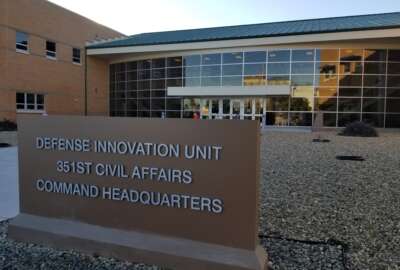Quick pivot during the pandemic highlighted DIU’s ability to solve DoD problems
Mike Madsen, the deputy director of Defense Innovation Unit, said his organization in 2021 published 26 solicitations for commercial solutions for which it received...
Best listening experience is on Chrome, Firefox or Safari. Subscribe to Ask the CIO on Apple Podcasts or PodcastOne.
The impact of the Defense Innovation Unit shouldn’t be measured in the number of agreements awarded or the amount of dollars obligated. Both, by the way, are breaking new records each year.
Rather, the impact of DIU should be measured in number of problems it helps solve for the Defense Department.
Mike Madsen, the deputy director of Defense Innovation Unit, said one of the best examples came during the early days of the COVID-19 pandemic. DIU was overseeing the development of a new application called the rapid the assessment of the threat environment (RATE).

“It was a prototype used to predict when men and women in uniform are going to come down with an infectious disease like flu. This was pre-pandemic,” Madsen said on Ask the CIO. “Those kinds of things that would impact readiness and can spread potentially through your organization. Well, we were almost complete with that prototype when the COVID pandemic started. Instead of going back through a requirements process, we just pivoted, and applied it to COVID environment and ran the prototype of RATE in the COVID environment.”
Madsen said about 10,000 service members participated and the app collected data from devices like wearable watches and other on-person devices.
The application detects biometric measurements of various the service members and feeds the information into a database where it applies artificial intelligence to predict when folks would get sick.
“We were able to perfect it to the point where we were able to identify folks who are going to get sick with COVID 48 hours before testing or symptoms indicated that they actually had COVID,” Madsen said. “From a unit perspective, if I’m a commander, now I have awareness of someone who is potentially going to bring that into the larger unit and we can pull them out, isolate them before they’re even infectious. From our DIU operations perspective, [the pandemic] was relatively seamless, but there were opportunities to help leverage commercial technology to solve Defense Department problems.”
Record year in 2021
Solving those problems for warfighters is DIU’s ultimate goal, and that by which is the organization constantly is proving its value.
Madsen said this is why DIU is always looking for the companies that are on the leading edge and doing innovative work that could help some solve some of DoD’s biggest challenges.
Since 2016, when DoD launched the innovation office, it has awarded 279 contracts and brought in 240 non-traditional vendors, based on the definition in the law.
In 2021, DIU published 26 solicitations for commercial solutions for which it received 1,100 proposals. The solicitations on average received 43 proposals each.
DIU says 86% of companies that have received awards are considered nontraditional vendors with 73% being small businesses and 33% being first-time DoD vendors.
Madsen said 2022 also is looking strong. As of March, DIU has awarded $1.5 billion in total contract value. Between 2016 and 2021, DIU obligated $893 million.
“What that tells me is that we have proven our value to our DoD partners as a way to rapidly bring in that commercial technology to bear on DoD problems and provided our return on investment to them,” he said. “It also tells me that not only have we proven value to our DoD partners, but we’re proving value to our commercial partners as well as a way to simplify that process of working with the department. So we’re pretty excited about that.”
Madsen said DIU is seeking to continue to improve its process and prove its value. He said currently it takes about 100 days to award a prototype, but DIU would like to get that timeline down to as little as 60 days.
“We increase the transparency with a commercial partner. We increase competition for our DoD partners, lower the time the vendor has to obligate to the solicitation,” he said. “We’re able to get more solicitations in, which is great because we can cast a pretty wide net. We’re able to use our commercial engagement team to go out into the ecosystem and really understand where is that that large magnitude of commercial investment taking place in the technology ecosystem, who are the companies that are really on the leading edge and doing really some of the fantastic innovation and development in that areas that we think are going to help some solve some of DoD problems.”
Expanding DIU’s reach
DIU is expanding its reach with offices in Silicon Valley, in Mountain View, California, in Austin, Texas, Boston, Washington, D.C. and the newest regional office in Chicago.
The reason for the six regional offices is two-fold. First, DIU wants to search out companies that are outside the typical technology corridors. Second is to promote more competition.
“We also accelerate cooperation. In this era of the broader strategic competition, demands collective cooperation so we are shifting to a regional focus to align government innovation entities within those geographic regions to make sure we’re getting the best technology from across the country, not just the technology hubs,” Madsen said. “We want to find the best technology that the U.S. has to offer. We also want to demystify the complex procurement process. If we can get all the government innovation folks together and rowing in the same direction, and engaging with our commercial partners, in one voice that it’s going to help us demystify that.”
Over the last few years, DIU has moved several projects that are showing promising results in the prototype phase.
Madsen highlighted the development of a 5G tactical network for the California Air National Guard.
“We’re able to rapidly set up a secure 5G mesh network for humanitarian assistance, disaster relief and first responders. If you think about forest fires, now we’re able to set up a very rapidly a 5G network for cellular coverage for those folks that is discreet and secure for them to continue executing their activities,” he said. “We’re using AI for predictive maintenance. The commercial sector saw this a long time ago, not just the airline industry, but other industries that use very, very expensive machines with a lot of moving parts and failure of any of those parts would result in a catastrophic outcome. What we’ve been able to do is apply predictive maintenance using AI to multiple platforms across the Air Force. We’ve seen an increase in machine capable rates and a decrease in unscheduled maintenance time. We are looking to continue scaling that one across all the platforms.”
A third example is around drones and making sure they are both built securely from a cyber perspective and by American-owned companies.
“We’ve had several prototypes with the Army that resulted in CyberSecure drones,” he said. “We were able to field those in less than 48 hours in response to the humanitarian refugee situation in Germany when the US pulled out of Afghanistan.”
Copyright © 2025 Federal News Network. All rights reserved. This website is not intended for users located within the European Economic Area.
Jason Miller is executive editor of Federal News Network and directs news coverage on the people, policy and programs of the federal government.
Follow @jmillerWFED







